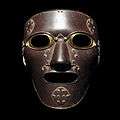Mempo
.png)
Mempo (also menpō, mengu[1][2][3] or occasionally men yoroi[4]), is the term for various types of facial armour worn by the samurai class and their retainers in feudal Japan. Types of Japanese facial armour include the somen, menpō, hanpo and happuri.
Description
Mempo were facial armour which covered all or part of the face and provided a way to secure the top-heavy kabuto (helmet). The Shinobi-no-o (chin cord) of the kabuto would be tied under the chin of the mempo.[5] There were small hooks called ori-kugi or posts called odome located on various places to help secure the kabuto's chin cord. Mengu may be constructed from iron or leather, or a combination of both. They may have a lacquered or rusted type of finish and can include a variety of facial details, such as moustaches, fierce teeth and a detachable nose.[6][7] Most mempo with the exception of the happuri had a small hole underneath the chin for sweat drainage.
Mempo are similar to masks worn by armored cavalry and infantry in ancient Chinese armies from the Han Dynasty to the Song Dynasty.
Types of mempo
Somen
Somen covered the entire face.
Menpō
Menpō covered the face from the nose down to the chin.
Hanbō (hanpō)
Hanbo covered the lower face from under the nose to the chin.
Happuri
Happuri covered the forehead and cheeks.
Parts of the mengu
- Odome, an attachment post for securing the chin strap of a kabuto (helmet).
- Ori-kugi, an attachment hook for securing the chin strap of a kabuto (helmet).
- Ase nagashi no ana, a drain hole (or tube) for perspiration located under the chin of various mengu.
- Yodare-kake, throat guard on various mengu.
See also
References
- ↑ Arms and armor of the samurai: the history of weaponry in ancient Japan, Authors Ian Bottomley, Anthony Hopson, Contributor Anthony Hopson, reprint, Publisher Crescent Books, 1993, Original from the University of Virginia, Digitized Aug 26, 2008, ISBN 0-517-10318-4, ISBN 978-0-517-10318-0 P.77,178, 186
- ↑ The Watanabe Art Museum Samurai Armour Collection (Kabuto & Mengu, Volume I) Trevor Absolon (Author), Brian Snoody (Illustrator), Barry Till (Preface), Anthony J. Bryant (Editor), Trevor Absolon & Dave thatcher (Photographer), Ian Bottomley (Introduction), Ian Bottomley & Anthony J. Bryant (Foreword) Publisher(Toraba), 2011 P.234
- ↑ Samurai: The Weapons and Spirit of the Japanese Warrior, Author Clive Sinclaire, ,Publisher Globe Pequot, 2004, ISBN 1-59228-720-4, ISBN 978-1-59228-720-8 P.30,138
- ↑ Samurai 1550-1600, Anthony J. Bryant, Angus McBride, Osprey Publishing, 1994 p.28
- ↑ Samurai 1550-1600, Anthony J. Bryant, Angus McBride, Osprey Publishing, 1994 p.28
- ↑ Samurai: The Weapons and Spirit of the Japanese Warrior, Author Clive Sinclaire, ,Publisher Globe Pequot, 2004, ISBN 1-59228-720-4, ISBN 978-1-59228-720-8 P.30,138
- ↑ he Watanabe Art Museum Samurai Armour Collection (Kabuto & Mengu, Volume I) Trevor Absolon (Author), Brian Snoody (Illustrator), Barry Till (Preface), Anthony J. Bryant (Editor), Trevor Absolon & Dave thatcher (Photographer), Ian Bottomley (Introduction), Ian Bottomley & Anthony J. Bryant (Foreword) Publisher(Toraba), 2011 P.234]
External links
| Wikimedia Commons has media related to Mengu (facial armour). |
| Wikimedia Commons has media related to Samurai armour. |
_full_facial_armour_1.jpg)



_menpo_2.jpg)